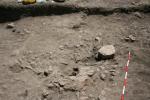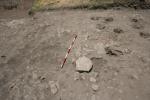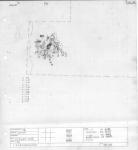Interpretation
-
- Hearth
-
- Darian Marie Totten
- 6-7-2009
Stratigraphic Relationships
- No Linked Records
Description
- color, composition
- trowel, brush
- see plan
- yellowish-brown, red elements
- cut by posthole
- artificial
- stones
- animal bones, large animal teeth
- glass, ceramics, tiles
- The feature is constructed of horizontally laid bricks of approximately 10 cm. In addition, a row of stones circumvents the feature in what would have been a circular pattern. The eastern segment is better preserved than the western, where a collapse has caused damage and made it almost indistinguishable from stratum 8088 (the friable black stratum at the west of the hearth/later intervention). The color of the soil at the internal part of the feature is yellowish-brown with red elements and contains elements of charcoal which goes beyond the preserved area. Flat tiles are around the exterior. The interior is primarily filled with small animal bones, along with fragments of glass and ceramics. The very compact clay on the interior showed traces of burning, had carbon elements on its surface, and showed the effects of heat. It likely represents a substructure for the hearth. The relatively friable soil had red traces in it, likely resulting from burnt tiles.
Ceramic Inventory
- 1075 AD - 1199 AD
- orlo verticale; spout of a pitcher with vetrina sparsa a;
| Total fragments | |
|---|---|
| 3 | |
| 3 | |
| 29 | |
| 4 |
Basic Information
- Circular feature composed of stones and tiles in the western end of the trench.
Plan
Record Details
-
- Lisa Fentress
-
- Darian Marie Totten
- 17-6-2009
- Darian Marie Totten
- 18-6-2009


